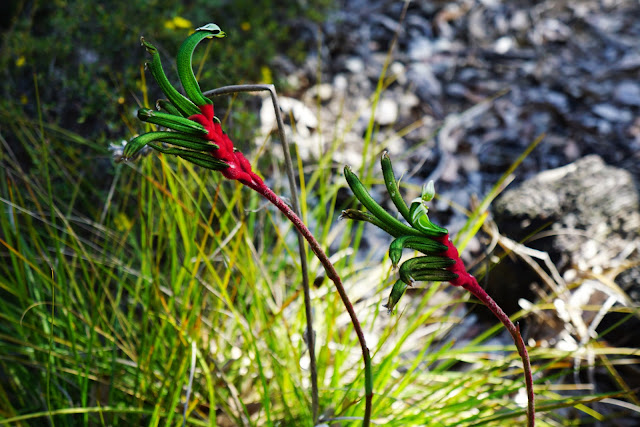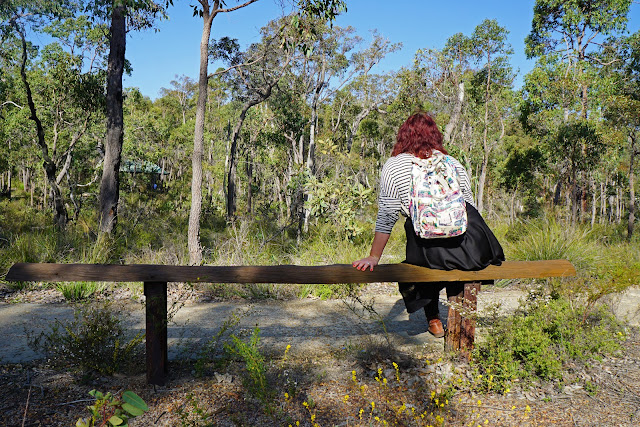A combination of two short loop walks in Crooked Brook Forest, the Jarrah Walk and Forest Path are accessible walk trails in an unusually fertile section of the Jarrah Forest. Following well structured purpose built walk tracks, the trail features a stunning wildflower bloom in the Springtime. With the Forest Path being wheelchair accessible, this family friendly Trails WA Top Trail is suitable for all.
Distance: 2.1 km (dual loops)
Gradient: Very gentle over the entire length of both loops.
Quality of Path: Purpose built walk trail with hardened surfaces for part of the Jarrah Trail and the entire Forest Path
Quality of Signage: Clear and easy to follow trailhead with some markers along each loop
Experience Required: No Bushwalking Experience Required
Time: 40 Minutes
Steps: No steps. The 600 metres of the Forest Path is wheelchair accessible
Best Time to Visit: Autumn-Spring, though Spring would be the most spectacular time to visit
Best Time to Visit: Autumn-Spring, though Spring would be the most spectacular time to visit
Entry Fee: No
Getting There: The trail starts at the main car park of Forest Road. From Boyanup Picton Rd, take Crooked Brook Rd east until it reaches a pine plantation an an unsealed road. This unsealed road is Forest Rd. Do not park at the first car park to the left of the road; the main car park is a short distance further down. Still recovering from Plantar Fasciitis and having pushed it a bit too far with the previous weekend's Kangaroo and Echidna Trails in Churchman's Bushlands, I decided to really scales things back and make our next walk a very short walk. As we were planning on heading down to Margaret River to help our friends with an event they were hosting, it made perfect sense to do a walk in the South West region, and the fact that the Crooked Brook Forest would only a be a short detour off the highway on our way back home to Perth made it an easy decision to finally check out the Forest Path Circuit. Well regarded enough by Trails WA to be considered one of the state's Top Trails, the Forest Path Circuit's measly 600 metres was too short even for my reduced mileage, and as such we decided to extend the walk to 2.1 kilometres by tackling the Jarrah Walk Circuit as well.
After visiting the trailhead in Crooked Brook's day use area, Alissa and I made our way back to the car park to start the Jarrah Walk in a clockwise direction. Even at this early stage of the trail, Alissa and I were thoroughly impressed by the wildflowers on display, with bountiful blooms literally visible from the car park.
The Jarrah Walk starts by entering a fairly open area of sparse Jarrah with a biodiverse understorey of Grass Trees and flowering heath. The open nature of the understorey reminded me a lot of the 'savannah' section of the Bibbulmun Track between Sullivan Rock and Mt Cooke, as well as the section of Preston National Park that the Bibb passes through not long after Mumballup.
Although the forest had a very open canopy, I was quite impressed by the fairly mature Jarrah in the area. In spite of the characteristally thin crowns, it was a nice change of pace from the usual thin and scrappy Jarrah to see some relative giants here in Crooked Brook.
Although Jarrah is quite far down my list of favourite Eucalypts, the open canopy does result in quite an impressive forest floor during wildflower season. Crooked Brook's wildflower display was quite exceptional; while I would rank it below such wildflower-spotting favourites as the Lesueur Trail, the Stirling Range and especially Fitzgerald River National Park, Crooked Brook Forest would be right up there with some of the best wildflower displays we've seen in Western Australia's South West.
One of the most intriguing plants on display were the ones pictured above. Looking like a cross between the Kingia Grass Trees (thanks to the alien antennae-like flowers) and the Pandani in Tasmania, I found these to be utterly intiguing.
A short way into the trail, the Jarrah Walk crosses a small stream, with two bridges on offer for walkers to have an element of choice. The newer one on the left is a newer structure of a higher construction standard, while the older wooden log crossing to the right had a rustic charm of its own.
In spite of a fairly quick change to warm weather towards the end of October and early November, Alissa and I were pleasantly surprised to see that there was still some water in the stream. Looking down into the water, Alissa and I were delighted by the sight of several tadpoles in various stages of metamorphosis. If you look closely just to the right of the middle in the photo above, you can see one of the stream's many tadpoles.
After the bridge, the walking is much of the same scenery of open canopy, a mix of thin young Jarrah with some older specimens and a plethora of wildflowers in the understorey.
While I'm sure the walk is very samey in other seasons, it was great seeing different wildflowers all along the walk. There were certainly a handful of flowers that were more common, but we were constantly being surprised by another new species the further along the walk we went.
Being a short, family friendly walk, it was unsurprising that there was a very high number of benches all along the walk. While the frequency of benches was probably a bit of overkill considering that the trail is not very long and/or challenging, it also makes this a very attractive trail for families and older or less fit walkers to get out there and experience nature.
Mere minutes (but several benches) later, Alissa and I found ourselves on a section of the Jarrah Walk shared with the Forest Path. Given that the Forest Path is a wheelchair accessible trail, this meant that the last few hundred metres were on a hardened surface suitable for those with mobility issues.
This last section of the walk features one of the most impressive sights along the walk - a dammed off section of the brook that provides a reliable water source for the wildlife in the area. Given the general drying trend of the south west, this artificial billabong is both an excellent buffer for the animals living in the Crooked Brook Forest as well as a lovely landmark for walkers to appreciate.
Beyond the billabong, the trail continues back to the start of the loop, with more benches and information panels all along the way.
On the day of our visit, we were lucky enough to spot some impressive Kangaroo Paw specimens along the way. Considering they are Western Australia's state emblem, I feel like I rarely see the classic red and green Kangaroo Paw out in the wild, with the tall Kangaroo Paw or the more velvety Cat's Paws being the ones I see the most often.
Back at the main day use area, Alissa and I passed an impressive number of outdoor barbecues and shelters. This would make the area a perfect place for a picnic with family or friends and we saw a group of elderly visitors enjoying the fine weather as they played cards under the most impressive of the shelters.
Having completed the Jarrah Walk's 1.6 kilometres without breaking a sweat, Alissa and I moved on to tackle the even shorter Forest Path Circuit.
Being a Class 1 trail, the Forest Path features a large wooden bridge right near its start that is wide enough to accommodate a wheelchair. this is quite an attractive looking bridge, and I can imagine it being a nice vantage point from which to view the flowing brook during the height of the winter rains.
As with the Jarrah Walk, the Forest Path features a plethora of benches all along the way. The scenery is much the same as what can be found on the Jarrah Walk, with a lot of wildflowers all along the trail.
I would suggest however that the wildflower display on the Jarrah Walk was the more impressive between the two. That being said, the denser Jarrah forest is a nice trade off that gave the walk a slightly different character.
Being extremely short, Alissa and I were completely unsurprised to find ourselves back at the billabong less than twelve minutes after having passed it the first time. From there, it was an easy walk following the same section of trail we'd walked the first time as we made our way back to the day use area.
The day use area features a fun little playground, and Alissa had some fun letting her inner kid out as she had a bit of a play.
I'm not usually a fan of short trails, and even with Plantar Fasciitis the 600 metres of the Forest Path seemed a bit light on to be rated as one of the state's Top Trails, even if accessibility was the main consideration. That being said, the 2.1 kilometre combination of the Jarrah Walk and Forest Path was a very enjoyable walk in terms of wildflower spotting, and while a longer trail would be preferable, the fact that these trails make such a nice part of the Jarrah forest accessible to a larger audience is a commendable thing. These are great family friendly walks that I can definitely recommend for those looking for a short and sweet encounter with some beautiful native bushland.


































0 comments:
Post a Comment